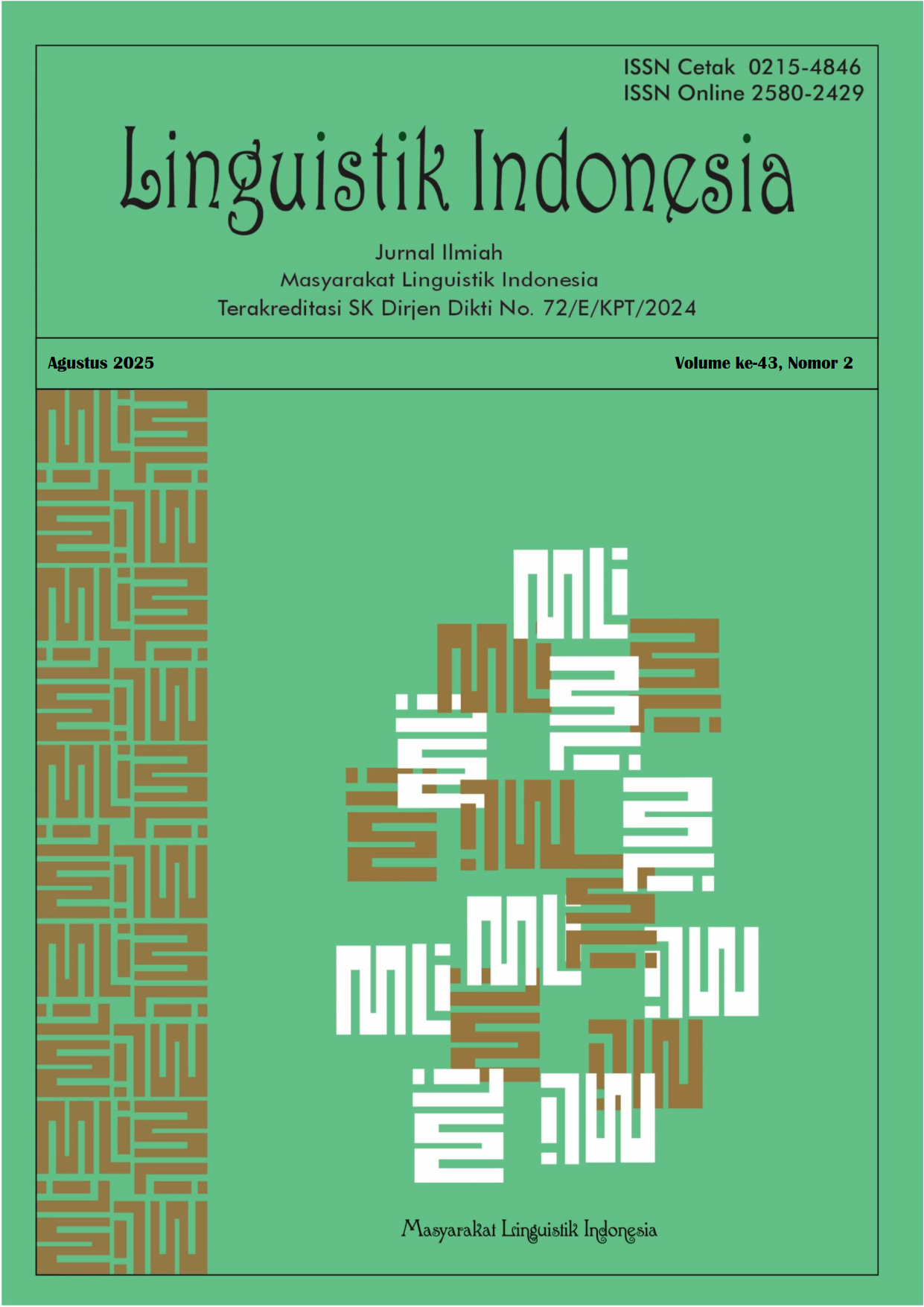Exploring Alienable—Inalienable Possessions in Yaben
DOI:
https://doi.org/10.26499/li.v43i2.798Keywords:
inalienable, morphological and phrasal possessive constructions, noun-noun juxtaposition, Yaben, alienableAbstract
This article discusses structural and semantic properties of possessive constructions in Yaben, a Papuan language of Trans New Guinea spoken in the South of Bird’s Head of New Guinea along the Kaibus River, South Sorong Regency. The purpose of the study is to explore alienable-inalienable possessive distinction in structural and semantic expressions in Yaben. In doing this research, the descriptive method was used, and the data were taken with an elicitation technique. The typological approach is also used as a comparative analysis between Yaben and other Papuan and Austronesian languages in the area. The finding of the study shows that the distinction between alienable and inalienable possessions is obvious at the structural and semantic levels. Two grammatical properties are used to indicate alienable and inalienable possessions, which are morphological and syntactic (phrasal) constructions. The morphological construction and noun-noun juxtaposition are used to mark inalienable nouns: kinship terms, body parts, common nouns, and associative nouns; while the possessive marker migine ‘POSS’ linking the possessor and the possessed noun functions to indicate the alienable noun: whole part relational nouns. Yaben shows a prototypical alienable-inalienable possessive distinction, as do other Papuan and Austronesian languages of Papua.
References
Aikhenvald and Dixon. (2013). Possession and Ownership: A Cross-Linguistic Typology. Oxford. Oxford University Press.
Arnold, L. (2018). A grammar of Ambel: An Austronesian Language of Raja Ampat, West New Guinea. A doctoral thesis. Edinburgh. The University of Edinburgh.
Asmah, Hj. O. (1974). The Possessive Phrase in the Western Austronesian Languages. Oceanic Linguistics, 13(1/2), 391-407. https://doi.org/10.2307/3622749
Berry, K. (1995). A Description of the Abun Language. Phonology and Basic Morphosyntax. An MA thesis. Bundoora. La Trobe University.
Bromley, H. M. (1981). A Grammar of Lower Grand Valley Dani. Pacific Linguistics. C-63. Canberra: Australian National University.
Burung, W. (2018). Alienable and Inalienable Nouns in Wano. Linguistik Indonesia, 36(1), 37-65.
Burung, W. (2023). Nonverbal Clauses in Wano: A Trans-New Guinea language. Oxford Research Encyclopedia of Linguistics. https://doi.org/10.1093/acrefore/9780199384655.013.917. Published online 31 January 2023.
Candra, P. and Kumar, R. (2012). Alienable-Inalienable Possession Distinctions. Indian Linguistics, 73(1-4), 35-45.
Cowan, H. K. J. (1951). Notes on Sentani Grammar. Oceania, 21(3), 214-228.
Crystal, D. (2008). A Dictionary of Linguistics and Phonetics (6th edition). Oxford: Blackwell Publishing Ltd.
De Vries, L. (2004). A Short Grammar on Inanwatan, An Endangered Language of the Bird’s Head of Papua, Indonesia. Canberra: Pacific Linguistics, Australian National University.
Dixon, R.M.W. (2010). Basic Linguistic Theory. Vol. 2. New York: Oxford University Press.
Doll, P. (2007). A Grammar of Maybrat, A Language of the Bird’s Head Peninsula, Papua Province, Indonesia. Unpublished doctoral dissertation, Leiden University.
Gardon, R. G. (Ed). (2005). Ethnologue: Languages of the World. Dallas: Summer Institute of Linguistics.
Gasser, E. (2014). Windesi Wamesa Morphophonology. A doctoral dissertation. New Heaven: Yale University.
Gebregziabher, K. (2012). The Alienable-Inalienable Asymmetry: Evidence from Tigrinya. Selected Proceedings of the 42nd Annual Conference on African Linguistics, Eds. Michael R. Marlo et al., 161-182. Somerville, MA: Cascadilla Proceedings Project. https://www.lingref.com/cpp/acal/42/paper2767.pdf
Haspelmath, M. (2008). Alienable vs. Inalienable Possessive Construction. Leipzig: Spring School on Linguistic Diversity.
Heine, B. (1997). Cognitive foundation of grammar. New York: Oxford University Press.
Himmelmann, N. (1998). Documentary and Descriptive Linguistics. Linguistics 36, 161-195.
Lichtenberk, F. (2002). The Possessive-Benefactive Connection. Oceanic Linguistics, Vol. 1, Number 2. 439-474. DOI: 10.1353/ol.2002.0008
Lichtenberk, F. (2009). Oceanic Possessive Classifiers. Oceanic Linguistics, 48(2), 379-402. DOI:10.1353/ol.0.0054
Lichtenberk, F. (2010). Southeast Solomonic: A View from Possessive Constructions. Oceanic Linguistics, 49(1), 259-277. DOI:10.1353/ol.0.0062
Mambrasar, D. N. (2011). Morphosyntactic Properties of Ansus. Skripsi. Manokwari: Universitas Papua.
Mofu, S. S. (2008). Biak Morphosyntax. A doctoral thesis. Oxford: University of Oxford.
McGroger W. B. (2009). Expression of Possession. Berlin: Mouton de Gruyter.
Miedema, J.; Ode, C.; and Dam, R. A. C. (1998). Perspectives on the Bird’s Head of Irian, Jaya, Indonesia. Proceedings, Leiden, 13-17 October 1997. Leiden: Leiden University.
Nida, E. A. (1949). Morphology the Descriptive Analysis of Words. Michigan: University of Michigan press.
Payne, T. (1997). Describing Morphosyntax; A guide for Field Linguistics. New York: Cambridge University Press.
Sawaki, Y. (2008). Person Marking Systems in Dani Languages. Linguistik Indonesia, 26(2), 129-150.
Sawaki, Y. (2007). Forms and Functions of Pronominals in Middle Yali. Linguistika, 14(27), 1-15.
Sawaki, Y. (2016). A grammar of Wooi: An Austronesian Language of Yapen Island, Western New Guinea. Doctoral thesis. Australian National University. https://openresearch-repository.anu.edu.au/bitstream/1885/136851/1/Sawaki%20Thesis%202017.pdf
Sawaki, Y. and Arilaha, A. (2014). Sentence Elicitation for Languages in Papua. Manokwari. Center of Endangered Language Documentation, UNIPA.
Sato, H. (2009). Possessive Nominalization in Kove. Oceanic Linguistics, 48(2), 346-363. DOI:10.1353/ol.0.0049
Silzer, P. J. (1983). Ambai: An Austronesian Language of Irian Jaya, Indonesia. A doctoral thesis. Canberra: The Australian National University.
Simons, E., and Fennig. (2019). Ethnologue: Languages of the World. 22nd edition. Dallas. Texas: SIL International.
Storto, G. (2003). Possessive in Context Issues in Semantics of Possessive Construction. PhD dissertation. Los Angeles: University of California.
Tursinaliyevna, J. Z. (2021). Descriptive and Comparative Linguistics. International Journal of Academic Pedagogical Research (IJAPR), 5(4), 5-6. www.ijeais.org/ijapr.
Van den Heuvel, W. (2006). Biak: Description of an Austronesian Language of Papua. A doctoral thesis. Amsterdam: Vrije Universiteit.
Tan, S. W. J. (2015). Linguistic typology: Possession. Asia-Pacific Linguistics, 2015. 1-37. DOI:10.13140/RG.2.2.17031.39840
Tylor, J. (1996). Possessive in English. Oxford. Oxford University Press.
Waren O. U. (2007). Possessive Pronoun in Maybrat: A Papuan Language. Linguistika, 14(27), 29-43.
Downloads
Published
How to Cite
Issue
Section
License
Copyright (c) 2025 Linguistik Indonesia

This work is licensed under a Creative Commons Attribution-NonCommercial-ShareAlike 4.0 International License.
The name and email address in this journal will only be used for the benefit of the Indonesian Linguistics journal and will not be used for other purposes.










